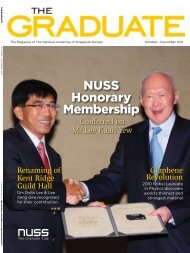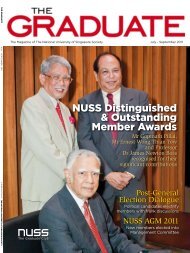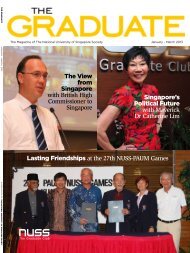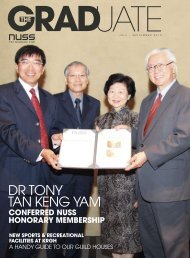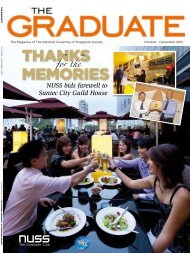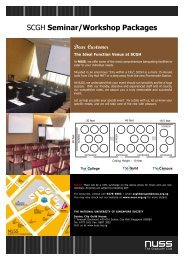Ben Cao GanG Mu - NUSS
Ben Cao GanG Mu - NUSS
Ben Cao GanG Mu - NUSS
You also want an ePaper? Increase the reach of your titles
YUMPU automatically turns print PDFs into web optimized ePapers that Google loves.
inside<br />
sTory<br />
0<br />
Another way of looking at the difference between Western<br />
Medicine and TCM is the direction magnification takes. With<br />
Western Medicine, technology is used to isolate the smallest<br />
possible particle that may be diseased – all the way down to<br />
the electrical charge of a molecule. For Chinese Medicine,<br />
through the eyes of the ‘human organism’, the big picture<br />
is perceived to be of a greater importance, not the electrical<br />
charge of a particular molecule or a cell with a leaky wall.<br />
Treatment and Diagnostic Techniques<br />
In TCM, prescriptions are usually focused on the individual,<br />
centred on the principle that every person is unique in our<br />
physical make-up. The prescription of herbal medicine is<br />
usually preceded by a diagnosis that observe symptoms. It is<br />
comprised of four methods – observe, hear, smell, touch and<br />
ask (medical history).<br />
These techniques are frequently used in conjunction with<br />
pulse-reading by TCM practitioners to comprehend the<br />
ailment and symptoms suffered by the patients. In some<br />
instances, this has led to the overall criticism that TCM is<br />
mainly based on treatments for counteracting the symptoms,<br />
without largely understanding the cause of the ailments. As a<br />
result, this hindered the acceptance of TCM in most Western<br />
societies, where understanding and distilling the science of<br />
diseases and ailments is key.<br />
The Comeback of TCM<br />
TCM however, is growing in popularity in some contemporary<br />
societies like Singapore. The main reason being, next<br />
to Western Medicine, it is increasingly considered as an<br />
‘alternative’, or ‘complementary’ treatment by a growing<br />
number of patients turning to TCM when Western Medicine<br />
fails to treat or relieve chronic disorders.<br />
This is especially so in the turning to acupuncture in relieving<br />
chronic pain such as backache or migraines.<br />
According to a My Paper report on 2 July 2009, Terrence Ng,<br />
an engineering manager, relied less on his doctor after taking<br />
TCM classes at the Singapore College of Traditional Chinese<br />
Medicine and noticing a marked improvement in health.<br />
This ties in with the theory that TCM is both a form of healing<br />
and also a treatment that works to strengthen the body. The<br />
rise in the number of practitioners can also be attributed<br />
to a cultural backlash where the younger generations<br />
are progressively seeking to embrace their roots with the<br />
modernisation of society.<br />
The number of applicants for courses at the Singapore<br />
College of TCM has jumped from 120 in 2008 to 200 in<br />
2009. The increase in the applicants, particularly of those not<br />
already in the industry, also accords a growing trust in the<br />
effectiveness of TCM in Singapore.<br />
TCM – Is It Really Effective?<br />
The effectiveness of TCM has always been a subject of<br />
contention. While traditionalists advocate TCM’s efficiency<br />
as an effective treatment method for various ailments,<br />
scientists claim there is no basis to the purported relieves<br />
that TCM can bring.




